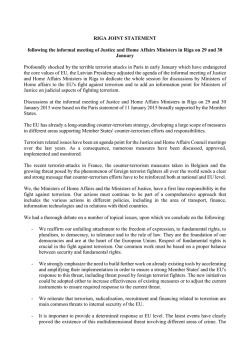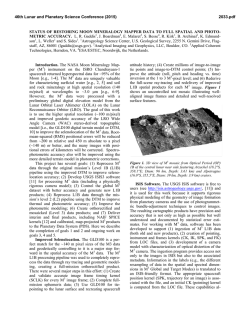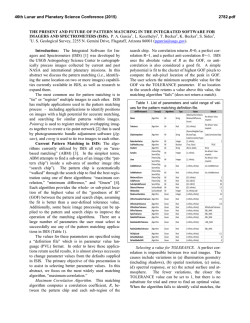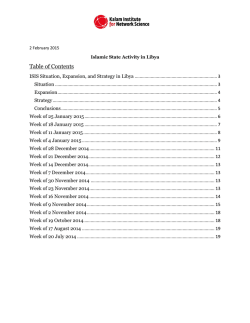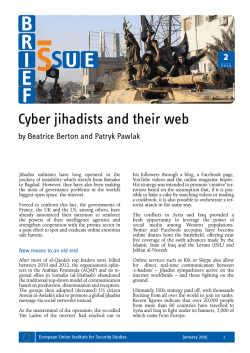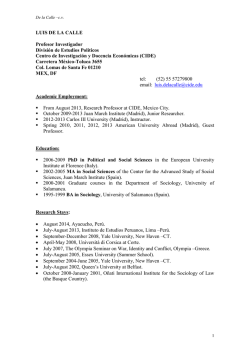
“The Twitter Terrorist”
White Paper on Digital Terrorism “The Twitter Terrorist” By Christine Duhaime, BA, JD, CAMS The Islamic State & the Age of the Digital Terrorist & Digital Terrorist Financing “One of the great liabilities of history is that too many people fail to remain awake through great periods of social change …our very survival depends on our ability to stay awake, to adjust to new ideas, to remain vigilant and to face the challenge of change.” Martin Luther King, Jr. “The most dangerous enemy today is the Twitter terrorist” EXECUTIVE SUMMARY Today’s most important battles against terrorism aren’t taking place on the deserts of Iraq or the streets of Syria, but on social media platforms like Twitter, Facebook and YouTube. The Islamic State (“ISIS”) has made clear that we are in a war against digital terrorists. ISIS is winning the digital terrorism war and will continue to do so unless the West mounts a digital counterterrorism offensive. ISIS has succeeded in digital terrorism for four main reasons: 1. Surveillance lag by the counter-terrorism intelligence agencies in the West. Highlights è New battlefield of digital terrorism è Why ISIS has succeeded in digital terrorism è ISIS’ digital strategy è Costs of losing the digital terrorism war è The need for PPP solutions in digital terrorism terrorism 2. Exploiting the lack of understanding by those driving counter-terrorism initiatives that young people today live on the online world where ISIS continues to invest in propagating terrorism on social media. 3. Failure of the creation of a public-private dialogue to create comprehensive and cohesive counter-terrorism strategy, leaving a vacuum of oversight by both sectors. 4. Failure to oppose digital terrorism in any cohesive manner. We need to understand ISIS’ digital terrorism strategy of: 1. Actively recruiting defectors from the West and lone wolves to act; 2. Aggressively engaging the rest of the world online to mould a generation of young people to glamourize terrorism out of social context; 3. Shocking the world with the brutality of their regime to gain media attention and provide proof of purchase to ISIS financers; and 4. Soliciting financing through social media platforms. The West should become familiar with the digital instruments of terror, close the digital divide, formulate a public-private partnership on counterterrorism, and oppose ISIS on social media with a meaningful counteroffensive that includes a compelling message. We will not have a growing and vibrant economy if we do not address international security and eradicate terrorism where it is presently happening – on the iPads and iPhones in the hands of every teenager watching ISIS’ Reign of Terror. © 2015, Christine Duhaime 1 White Paper on Digital Terrorism NEW BATTLEFIELD OF DIGITAL TERRORISM If there is one thing the international crisis with the Islamic State (“ISIS”) has made clear, it is that we are in the midst of something we haven’t faced before, namely, a war against digital terrorists where the most important battles are fought not on the battlefield, but online. ISIS’ key weaponry against the West in digital warfare is not guns, swords and bombs – it is computers, cell phones, the Internet and social media. The most dangerous enemy today to the West is the Twitter terrorist and that’s because such a terrorist has, with the click of a mouse, the global capacity and reach to radicalize others to commit domestic terrorist acts, defect to places like Syria, Yemen or Libya to engage in terrorism or send funds to maintain the operations of the terrorist organization. ISIS is winning the digital terrorism war by a long shot and will continue to win for years to come unless the West mounts a competent digital counter-terrorism offensive. WHY ISIS HAS SUCCEEDED IN DIGITAL TERRORISM Organizations like ISIS have succeeded in digital terrorism for four main reasons: 1. Surveillance Lag Counter-terrorism intelligence agencies took too long to realize the extent to which terrorist groups, such as ISIS, were engaged in digital terrorism and the success of their messaging and global reach. They also took too long to start monitoring ISIS on social media and grasp the impact of their digital terrorism activities, including the ability to engage in digital terrorist financing. 2. Digital Divide A deep digital presence is a modern thing occupied by young people who are being utilized by ISIS for terrorism efforts, but not by the West for counter-terrorism. They get digital terrorism – their parents who make counterterrorism decisions often do not, and, therefore, often fail to appreciate the risks of digital terrorism. The Twitter terrorist is typically not an adult male in Syria, nor is it Abu Bakr al-Baghdadi – more often than not, it’s a well-educated teenage ISIS bride from the West locked in an apartment in Syria, or a young woman in the UK. The Twitter terrorist engages on social propagating terrorism 24/7 with a global reach. © 2015, Christine Duhaime media It is important to understand two things in respect of Twitter terrorism - any young person in the US, UK, France, Australia or Canada with a computer or mobile device and Internet access is a potential Twitter terrorist and is a also a potential victim of ISIS radicalization. A Twitter terrorist is also likely a victim of radicalization herself – she knows what works to recruit defectors, radicalize other teens and obtain funding for such operations digitally because she herself was radicalized. ISIS is very good at pitting the West against itself – we see that with ISIS placing defectors from the West at the front lines so that Western troops are faced with the prospect of having to fight their own citizens on the ground in Syria. The same is true in digital warfare. ISIS is using our technology platforms and our corporations to promote terrorist acts to harm us. Shockingly, we let them. Twitter terrorists follow Twitter trends with dedication in target countries such as France, Russia, Germany, the US and Canada for recruitment. They use trending hashtags to reach new audiences among the teenage population by adding a trending hashtag to tweets. Typical ISIS Tweet to Radicalize Western Teenagers ISIS Tweet with popular or trending hashtag followed by teenage boys with link. Link leads to JustPasteIt file posted by ISIS. JustPasteIt file opens ISIS video calling for violence against kuffars in Canada, US & France. In the example below, ISIS used a trending video game hashtag #URF2015, to target teenage boys. When teens click on the link in the tweet, they are taken to a webpage hosted by Sendvid.com, a US company that facilitates anonymous uploading of videos, where they can watch a Hollywood-quality video by ISIS called “Inside Halab.” The video is narrated by UK kidnap victim John Cantile who extols, inter alia, the virtues of ISIS’ agricultural activities and the efficiency of cutting off the arm of a person convicted of robbery by a Shariah court, which ends with a call for ISIS sympathizers in the West to become “lone wolves” and kill us. 2 White Paper on Digital Terrorism 3. Failure of Public-Private Dialogue Because modern terrorism is largely dependent upon digital operations, which by its scope extends beyond national boundaries, it is self-evident that no one country can defend digital terrorism alone and nor can it be defended solely by the public sector. Example of manipulative hashtag used by ISIS. The use of trending hashtags on Twitter to draw people to ISIS is becoming more pervasive. The two examples below are illustrative. The private sector owners of social media platforms took too long to act, and often still fail to act, to the use of their services to host or publish terrorist material and propaganda that are used to recruit defectors to Syria, radicalize others to commit terrorist acts and for terrorist financing. ISIS publishes material on social media sites owned or controlled by public and private corporations in the West that incite the commission of acts of war and treason, call for the overthrow of democratically elected governments, incite acts of violence, hatred and war crimes, and provide mechanisms for terrorist financing. When its comes to terrorist financing, providing material support to a terrorist organization and the hosting or publication of terrorist material that incite acts of war, treason, war crimes or hatred, it is incumbent upon social media companies to know and comply with the law. ISIS uses #RoyalBaby hashtag. ISIS uses #BalitmoreRiots hashtag. In the West, the digital divide means that the public sector is not effectively monitoring this type of terrorist propaganda by Twitter terrorists and nor do they demand that hosting companies remove terrorist material from their websites. Various organizations and individuals in the private sector, on their own initiative, have stepped in to fill this public safety role by tracking Twitter terrorists and asking social media companies to terminate their accounts. © 2015, Christine Duhaime Social media companies are not entirely to blame in all aspects of counter-terrorism failures – it is incumbent upon the public sector to educate and inform businesses and individuals alike on terrorism and counter-terrorism. National defence and security are the purview of the government. There are few counterterrorism efforts targeted at the private sector in the West, with the exception of perhaps the financial services sector in a limited fashion for counter-terrorist financing only. Some non-US government agencies have taken the position that since most social media companies are parented in the US, it is up to the US government to regulate their conduct in respect of counter-terrorism. However, corporations that provide services in foreign countries are subject to the publication and terrorism laws of all of the countries in which they provide services. The inactivity of the public sector to engage in digital counter-terrorism has led to an odd situation whereby cyber-hacking groups are filling digital counter-terrorism gaps by shutting down social media platforms that provide services to Twitter terrorists, such as with #OpISIS. Although highly effective, this is not the principled approach we should be relying upon. What is needed is a referral unit as part of a public-private 3 White Paper on Digital Terrorism partnership institution where terrorist propaganda can be referred and examined by experts and removed in cooperation with industry partners. ISIS forbids the wearing of jeans. Tweet from DigitaShadow on #OpISIS movement. 4. Failure to Oppose Digital Terrorism The West has failed to mount an effective digital opposition force against ISIS on a national or global level or in a coordinated fashion. There are three things we are battling with the Twitter terrorist: (i) radicalization that leads to acts of domestic terrorism; (ii) radicalization that leads to defection to Syria and acts of foreign terrorism; and (iii) radicalization that leads to terrorist financing. All three are destabilizing and threaten international security. And in all three, the Twitter terrorist is selling a susceptible teenager or young adult ISIS’ way of life. Although in the West, we also have something to sell as a counter-terrorism message to susceptible young adults targeted by ISIS, we fail to do so. What are we are selling is obvious – it’s democracy. To a nineteen year old, living in a democratic society means they have rights and freedoms they lose with ISIS; in the West they can go to college, go on dates, download music and TV shows on iTunes, own an iPhone, text their friends, lounge on the sofa watching a movie, walk the dog, watch videos on YouTube, play organized sports, buy jeans, travel freely or eat at McDonalds. And they can do all of those things unimpeded and without fear of incarceration or death, as may occur living under ISIS’ regime. Not many teens in the West want to live in a society where the only laws, rights and privileges permitted are those from 1,4000 years ago, and likewise not many want to give up the benefits of democracy. Some Twitter terrorists who have defected to Syria tweet about things they miss about the West, such as hugging a parent, seeing their family, buying fashionable clothing, having uninterrupted high-speed Internet service or electricity and eating a hamburger. These are not trivial or shallow motivators for counter-terrorism – since the beginning of time, humans have striven for more creature comforts, not less. People raised in the West do not lightly give these up. Young men whipped by ISIS for drinking beer. ISIS’ DIGITAL TERRORISM STRATEGY ISIS’ digital terrorism strategy has four parts. 1. Recruitment of People & Terrorist Acts ISIS’ first digital terrorism strategy, which has been immensely successful thus far, is to recruit sympathizers to defect and join them in Syria, through the porous borders of Turkey. They recruit young men and women from all corners of the world primarily in English, French, Arabic, and Russian to join the cause and become fighters, jihadists, computer programmers, hackers, doctors, engineers, teachers, propagandists and brides. ISIS is rebuilding the first modern Islamic State and all are welcome who believe in the cause want to live in the caliphate under Shariah law and are prepared to formally renounce allegiance to their country of origin in favour of the Islamic State. The prospect of joining a “new” state and helping shape it is a powerful draw. ISIS Targets West for Defectors This story on CNN is a good example of how ISIS uses social media to recruit people in Minnesota to join them. © 2015, Christine Duhaime 4 White Paper on Digital Terrorism The targeting of Minnesota youth is not random; ISIS officials research and target certain areas and groups for radicalization that it believes are more vulnerable and capable of being manipulated. Tweet to attack Garland, Texas. 2. CNN report on recruitment hot spots. Western nations say 5,000 to 10,000 foreign nationals have defected to join ISIS from around the world. However, people on the ground in the area, such as the Kurds, report that it is closer to 50,000, to 80,000 which is likely more accurate. Engagement & Impact with the World The digital terrorism strategy of ISIS also includes an engagement component with the world. It is premised on ISIS’ theory that by engaging with everyone on social media and widely publishing their propaganda, they will have impact. Whether the impact is positive or negative is irrelevant – the goal is to enter Western consciousness. Tweeting Videos Videos are a cornerstone of ISIS’ digital media strategy. As this tweet demonstrates, ISIS has analytics to track which of its videos are the most popular. Lone Wolf Recruitment ISIS also uses social media to recruit and direct sympathizers to commit domestic acts of terrorism in their own country. That this has succeeded is not disputed – there have been numerous ISIS inspired attacks, including two in Canada, that evidence the effectiveness of digital terrorism efforts by ISIS. ISIS has published countless movies and written directives in numerous languages that are targeted at young men that implore them to commit terrorist acts at their places of employment or on their streets against “kuffars1.” ISIS recruits online using multiple social media platforms such as Twitter, Facebook, YouTube, Tumblr, Vine, Kik, WhatsApp, Ask.fm and JustPasteIt. The primary source is Twitter, which is used to link recruits and sympathizers to other platforms where videos are published. A chilling example of ISIS using Twitter to compel lone wolf attacks in the West, its effectiveness and our failure to engage in digital counter-terrorism to stop it arose in the May 4 attacks in Garland, Texas, in which two sympathizers attempted to attack attendees with weapons at a cartoon contest. On May 1, 2015, we came across tweets imploring attacks in Garland, Texas, such as the one below. A few days later, there was an ISIS inspired attack in Garland. Will be catch the next lone wolf attack announced on Twitter, and in time? A kuffar is a derogatory term meaning an infidel or non-believer but tends to exclude ‘People of the Book’, the latter of which are people who are Christian or Jewish. 1 © 2015, Christine Duhaime Tweet on Top 10 ISIS video releases. 5 White Paper on Digital Terrorism Every Twitter terrorist has a Hollywood-style movie studio behind her producing an endless supply of terrorist material used for recruitment and financing that is shared around the world by thousands of other Twitter terrorists. Gruesome movies are popular. Tweeting to Influence the Next Generation With respect to impact, the best example of the impact of ISIS’ digital terrorism engagement strategy is the effect it is having on children who are the largest consumers of digital media, ergo digital terrorism. Very young children are watching ISIS’ Reign of Terror on YouTube and when those videos are deleted, on JustPaste.It or Ghostbin. Children are now emulating ISIS’ behaviour in mock beheadings and such. In late March 2015, five children in Italy were suspended from school for a mock re-enactment of ISIS beheadings and posting the pictures on Instagram and WhatsApp. An Italian newspaper posted one of the Instagram photos online, below. Children re-enacting ISIS mass beheading video. Tweet reporting simulated beheading in Italy. In late February, 2015, a group of teens in Yemen filmed a mock re-enactment of the beheading of 21 Egyptian Christians that ISIS beheaded earlier that month. Below are stills of the children’s re-enactment and the equivalent frames in ISIS’ original video. Caliphate Cubs Syndrome ISIS’ battle for the control of young minds and hearts isn’t just digital. The ‘caliphate cubs’ syndrome is resulting in the indoctrination of a generation of young Syrians and Iraqis into the world of digital and physical terrorism on an incredible scale. Even if ISIS is defeated, the million of so incredibly young children in ISIS controlled territory will present challenges for years to come. There are many pictures on JustPaste.It and Twitter like these below, of ISIS children in Syria packing real guns and swearing allegiance to ISIS, and videos of them learning to kill “kuffars”. There are ISIS schools and training camps for children where they are fed a daily dose of hatred, intolerance and violence, and repeatedly shown ISIS violent videos of the deaths of “kuffars”. There are also a clip in a video of a young boy being taught how to deal with girls who © 2015, Christine Duhaime 6 White Paper on Digital Terrorism have been enslaved by ISIS that are on social media and available to Western children. ISIS is socializing children all over the world, creating little caliphate cubs beyond Syria and Iraq. That, if for no other reason, is why it seems imperative to have digital terrorism counter-offensive leadership; the longer we delay, the more innocent children in Syria and around the world become indoctrinated and radicalized. 3. Shock The West The third part of the digital terrorism strategy is to “shock the West” and that involves committing and posting on social media, violent, gruesome and offensive war crimes and crimes against humanity committed in order to compel the West to enter into a physical on-the-ground war in Syria. Two years ago, ISIS correctly determined that the more gruesome, the more inhumane, the more shocking their behaviour, as a terrorism strategy, the more the West will be compelled into action. Young children of ISIS role-play an execution. Young boy in Syria shows allegiance to ISIS. The most horrific ISIS video to date of the death of Moaz al-Kasabeh, the Jordanian pilot, is still published on social media platforms owned by Western companies. Horrific death of Moaz al-Kasabeh on Western-owned social media. Part of this strategy feeds into a larger ISIS digital media strategy to dominate the media around the world. They know that shocking or gruesome behaviour is newsworthy. That they have been successful in this initiative is also evident – every news cast around the world now leads with an ISIS-related story, whether it be Syria, Iraq, Nigeria, Yemen, France, Jordan, the UK or Canada. Picture of ISIS newborn with weapons. ISIS has warned that even if we eradicate them, their indoctrinated children will cause us harm for decades to come. They may be right. © 2015, Christine Duhaime The “shock the West” strategy has a side benefit for ISIS that they learned from their time as part of al Qaeda, which is that when horrific videos are posted online, sympathizers in the Gulf States and in the West respond with financing. Part of the terrorist financing culture is “proof of benefit”, meaning that terrorists have to provide proof on social media platforms to their financiers in order to obtain additional funding. They provide proof of benefit by committing and videotaping attacks that destroy critical infrastructure or cause the deaths of many “kuffars” and uploading the videos onto social media platforms. 7 White Paper on Digital Terrorism The “caliphate cubs” syndrome is an example of shocking the West – ISIS had videotaped young boys executing people and posted them online to shock a Western audience. If there was any dispute about that, it was dispelled in the last edition of ISIS’ Dabiq Magazine in which ISIS wrote, in reference to those videos: “as expected, the kuffar were up in arms about the Khilafah’s use of child soldiers.” A few days ago, ISIS released a high-resolution video showing a young boy of Eastern European descent executing a man with a gun at point blank range. An ISIS sympathizer tweeted: “Kuffar are gonna rage over this lool “ISIS forces innocent boy to kill civilian” hahahaha”. 4. Terrorist Financing As noted above, ISIS is not the first Islamic State and Abu Bakr al-Baghdadi is not the first person to declare a caliphate and assume jurisdiction territorially, culturally and religiously. Watching ISIS is like re-reading the history of the ancient world, only fast forward 1,400 years. Large portions of their terrorist financing is based on fundraising practices that existed in the first Islamic State, such as the sale of women into slavery to men, taxes imposed on Christians for the right to continue living and extortion on commercial activities across the board. ISIS fighter solicits terrorist financing on Facebook by selling a Yazidi “slave” girl for $350. Tweet of an ISIS video of a young boy executing a man. Predictability ISIS is an immensely predictable terrorist group. Part of their predictability stems from the fact that they are reversing the clock 1,400 years to recreate the first modern Islamic State. Separate and apart from predictability based on historic patterns of behaviour, they are predictable because they are transparent on digital media with respect to their goals, desires, objectives, strategies and activities. They have thousands upon thousands of Twitter accounts and are quite transparent and informative on all of them. The burning death of Moaz al-Kasasbeh is one such example, where ISIS tweeted that he was dead (and he was), yet the media continued to report that negotiations for his release were taking place. With respect to the “shock the West” strategy, ISIS’ behaviour will become predictably more repugnant in terms of human suffering and war crimes as time goes on and we should brace for that eventuality. We have not seen the end of ISIS’ Reign of Terror against “People of the Book”, especially Christians and young children. Predictably, the worst is yet to come. © 2015, Christine Duhaime But what is different is that the financing for terrorist activities has become digital. For example, slavery by ISIS may be a reinstitution of ancient practices from earlier caliphates but now sales of such abhorrent practices can be international and payments can be digital. More broadly, ISIS solicits funds on Twitter, Ask.fm, WhatsApp, Facebook and JustPaste.It, to name a few, for a myriad of purposes and from around the world. Although these amounts are quite low in order to fly under the radar of terrorist-financing reporting requirements under anti-money laundering laws, collectively, they are significant. “You see these appeals on Twitter in particular from well-known terrorist financiers asking for donations to be made -- and they’re quite explicit -- that these are to be made to ISIL for their military campaign. And that makes the efforts of countries in the Gulf … more difficult, because these are appeals that are made over social media and made broadly.” ~David Cohen, Fmr. Under Secretary of the Treasury for Terrorism and Financial Intelligence Quote from the testimony of CIA’s David Cohen. Emerging digital terrorist financing activities are taking place on the deep web using TOR, an area that is unfortunately not being monitored as it should. An 8 White Paper on Digital Terrorism organization such as ISIS is well-versed on, and uses TOR to access the deep web for its communications and fund-raising activities. appear also to be individuals who are willing to buy girls enslaved by ISIS. Below is a tweet by an individual whose Twitter account alleges he is a Canadian who replies to a tweet about a Yazidi slave girl with a purchase request. ISIS sympathizer tweets reminder to use TOR. Deep web to fund terrorism “without a trace”. In the Tumblr post below posted just weeks ago, a Canadian who defected to Syria to join ISIS, calls for sympathizers to “collect money from others” for ISIS fighters, assuring donors that terrorist financing can be done “safely and securely” and requesting donors contact him on KIK for instructions on funding ISIS. “Can I buy one too? Send one to Kuwait pls.” Tracking terrorist financing digitally is only possible if we are engaged in counter digital terrorist financing against ISIS to detect and prevent digital terrorist financing. THE COSTS OF LOSING THE DIGITAL TERRORISM WAR That the West has failed to remain “awake” throughout the emergence of digital terrorism seems obvious. In Syria and Iraq, almost ten million people have been rendered refugees living below the poverty level; hundreds of thousands of people have been killed; tens of thousands of young Christian and Yazidi girls have been sold into slavery and are missing; thousands of antiquities have been destroyed and the infrastructure of Syria has all but been destroyed. While terrorists may inevitably attack our critical infrastructure in an attempt to create chaos to forcibly install their ideology in the same way they have done in Syria, those attacks can only occur if they succeed in their digital terrorism efforts to recruit people and obtain financing or banking relationships. FINDING SOLUTIONS Tumblr used for terrorist financing by Canadian soliciting funds for ISIS. What is the solution to counter digital terrorism? A Canadian asks to buy Yazidi “slave girl” The solutions are simple. As Martin Luther King, Jr. said, we need to “stay awake, adjust to new ideas, remain vigilant and face the challenges.” No one in ISIS is smarter than our brightest people and ISIS does not There are individuals in the West who fund, or who appear willing to fund, ISIS openly on social media. There © 2015, Christine Duhaime 9 White Paper on Digital Terrorism have more superior technology than us and yet they are winning the digital terrorism war. In the West, we seem incapacitated when it comes to facing the challenges posed by digital terrorism. To cure the problems that allow terrorist groups to thrive on our social media platforms requires leadership, commitment and investment to mount an effective digital counterterrorism strategy. The five key things we need are as follows: 1. Engage in social media for counter-terrorism Intelligence agencies and law enforcement should become versatile in, and use, the new weaponry of terrorism, namely Twitter, WhatsApp, Kik, Ask.fm, JustPaste.It, Tumblr and the like. Because a group like ISIS is predictable, it is easy to engage them on social media and to use their propensity for social media engagement against them. We should not forget that the Twitter terrorist is a teenager, likely from the West, spewing out propaganda. That such a Twitter terrorist would respond to women intelligence agents more effectively than men should be obvious. We need Twitter terrorist counter agents. the pubic and the private sector to work collaboratively and for there to be a permanent vehicle to bridge the two sectors for that collaboration. We also need, at such an institution, the capacity to refer terrorist propaganda for identification and removal. 4. A digital counter-terrorism presence We should oppose ISIS on social media with meaningful compelling messages. Those who are susceptible, the target audience, are young people, and counter-digital terrorism messages targeting young people should be created with their input and contain messages that are meaningful to them, not to us. Below is a tweet that depicts how members of ISIS watch movies in Syria – huddled around a tiny smartphone screen. How many teens would prefer to watch only an ISIS approved movie this way instead of watching Netflix on their parents’ giant TV in the West with popcorn, chips and Pepsi? Not many. 2. Close the digital divide Western intelligence agencies should be closing the digital divide by becoming versed on digital terrorism and digital terrorist financing by acquiring expertise in this area. For example, some law enforcement agencies seem not to be aware that there are anonymous services that allow a person from anywhere in the world to send money or digital payments merely using email addresses to anyone else in the world through payment processors. How do we know that ISIS, or its lone wolves in the West, do not receive digital financing to fund terrorist attacks? We don’t because there is a significant knowledge and FinTech gap when it comes to digital finance for potential terrorist financing that needs to be examined. Canada especially, has fallen behind the rest of the modern world in adapting and understanding FinTech. 3. Form public-private partnerships We should form national public-private partnerships on counter-terrorism that include a digital component, and appoint a Digital Counter-Terrorism Officer in each country who works with other such national appointees, national agencies and the private sector. Social media companies have a vested interest in not allowing their platforms to be used for terrorism but they lack the knowledge of terrorist threats that the public sector should provide. It is naïve to believe that only the public sector can counter terrorism effectively – we need both © 2015, Christine Duhaime How ISIS fighters watch movies. Few young adults would even get on a plane from the West to Syria if they knew they would be prohibited from doing the millions of things young adults are naturally driven to do, can do, and love to do, because they live in a free and democratic society. Terrorist propaganda from terrorist organizations such as ISIS on social media platforms is effective for recruitment of attacks and terrorist financing because it is emotional, not intellectual. A counter-terrorism digital campaign from the West must likewise be emotional. 5. Invest in counter-terrorism Whatever the cost, we should spend the money and invest in digital counter-terrorism. ISIS invests significantly in digital terrorism efforts, in the tens of millions of dollars annually, and yet except for France and the US, Western states balk at the suggestion of 10 White Paper on Digital Terrorism investing to counter the most dangerous forms of modern terrorism in existence – digital terrorism. Investing in digital counter-terrorism is a proverbial drop in the bucket compared to the costs of a terrorist attack on critical infrastructure. 9/11 resulted in the loss of 30% of office space and the loss of many businesses that ceased to exist. 200,000 full time jobs were eliminated or relocated out of New York City. The destruction of physical assets costs private businesses $14 billion and government agencies $2.1 billion. Rescue and clean-up costs were $27.2 billion. Insurance, airline, shipping and military sectors had long-term costs that are incalculable. Another such attack will have similar devastating costs including more importantly, costs to human life. The West is going to be attacked again, whether it be more lone wolf attacks or a concerted large-scale attack to critical infrastructure. Whether we continue to sustain such attacks depends directly on the extent to which we invest financially on digital counter-terrorism. In the West, including Canada, the US, France and the UK, there should be nothing more important, as a matter of policy, than digital counter-terrorism, including its counterterrorist financing components with emerging FinTech payment methods that can be made anonymous and untraceable. Recent ISIS sympathizer tweet of old video, tweeted not for its content but for its message. We will not have a growing and vibrant economy in the West to protect, and nor will we have the democracy based on the rule of law that our ancestors fought to establish, if we do not address international security issues and invest in eradicating terrorism where it is actually happening with frequency and permanency – on the iPads and iPhones in the hands of every ten-yearold watching ISIS’ Reign of Terror. For more information about Duhaime Law visit www.duhaimelaw.com Legal Notices Copyright Contact Copyright Christine Duhaime. All rights reserved. Christine Duhaime Head of Regulatory Law (604) 601-‐2046 [email protected] Reproduction is authorised provided the source is acknowledged. Disclaimer This White Paper is provided for information only and is current as at May 6, 2015. If a client or any third party decides to take any course of action or omission based on this report and/or any conclusion contained therein, they shall do so at their own risk, and we are not liable for any loss or damage, arising from their acts or omissions based on this report or any recommendations contained therein. © 2015, Christine Duhaime 11
© Copyright 2025
